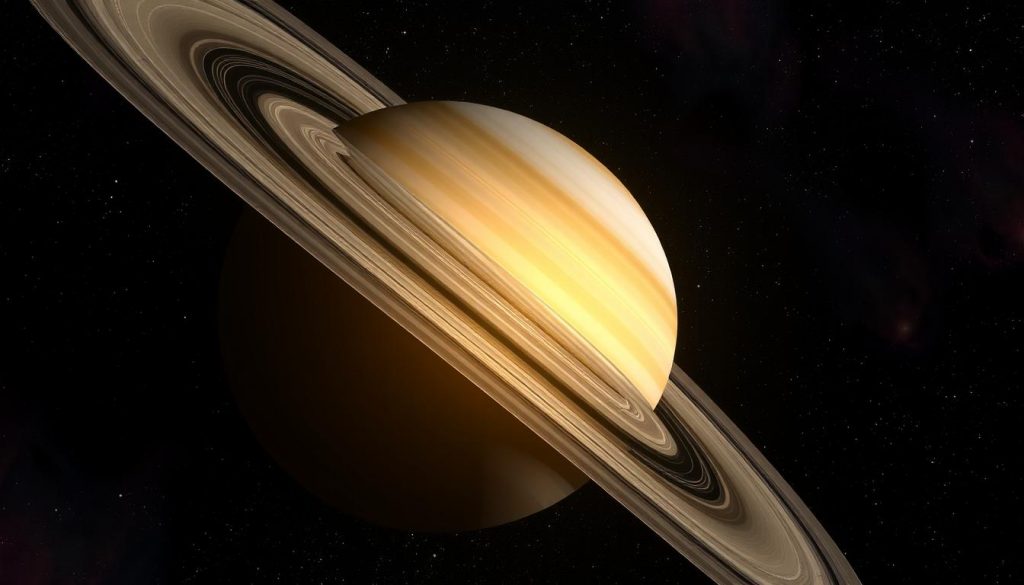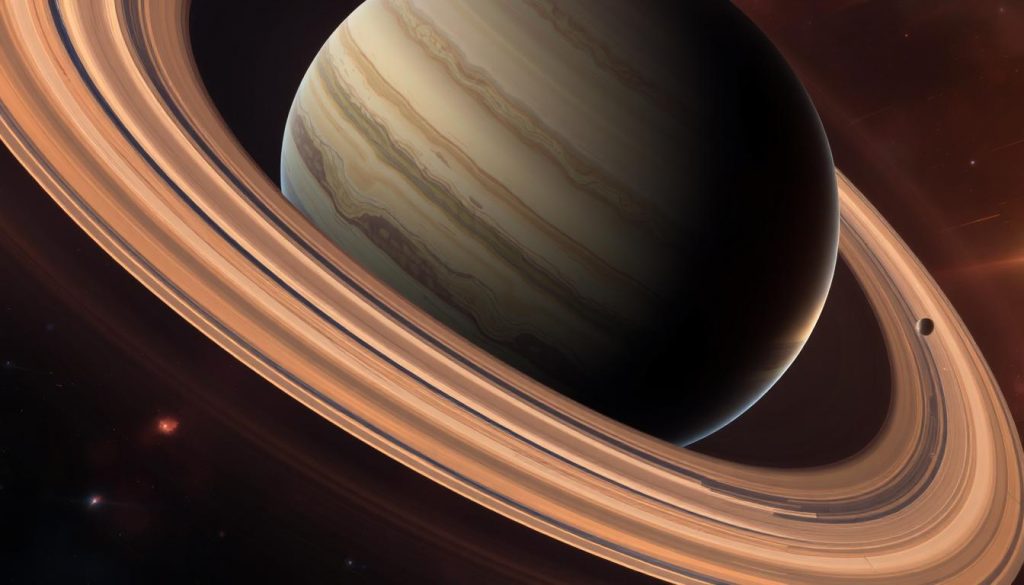Saturn’s Shepherd Moons: Guardians of the Rings
Saturn’s shepherd moons are key players in keeping the planet’s rings looking amazing. They are known for their beauty and complex design. Moons like Daphnis and Pan use their gravity to guide the ring particles.
Anúncios
This article will show how these moons help keep Saturn’s rings in top shape. We’ll dive into the amazing world of Saturn’s rings and the moons that protect them. It’s a journey through space that reveals the beauty of these celestial guardians.
The Fascinating Structure of Saturn’s Rings
Saturn’s ring system is a stunning sight, filled with icy beauty. It has a complex system of rings, including the A, B, and C rings. These rings are mostly made of water ice with some rocky material. They range in size from tiny particles to large chunks, creating a shimmering halo around Saturn.
The B ring is the widest and most reflective, making Saturn’s rings shine brightly. The A ring is just outside the B ring and has interesting gaps and divisions. The C ring, also known as the Crepe Ring, is the innermost and thinnest, making it unique.
The Cassini Division is a significant gap between the A and B rings, about 4,800 kilometers wide. This gap adds to the beauty of Saturn’s rings. The gravitational pull of Saturn’s moons helps keep the rings stable, like shepherds.
The rings are thought to be between 10 and 100 million years old. Saturn’s tilt of 27 degrees affects how we see the rings from Earth. Research shows that studying Saturn’s rings helps us understand how such wonders are formed.
| Ring | Width | Thickness | Composition |
|---|---|---|---|
| A Ring | Width: Varies, ~14,600 km | 10 m – 1 km | 99.8% ice, rocky materials |
| B Ring | Width: ~25,500 km | 10 m – 1 km | 99.8% ice, rocky materials |
| C Ring | Width: ~8,000 km | 10 m – 1 km | Heavily less reflective ice |
Understanding Saturn’s Shepherd Moons
Shepherd moons play a key role in the beauty of Saturn’s rings. They were first thought of in early 1979. The first pictures were taken by Voyager 1 later that year. These shepherd moons are small and close to the rings, pulling on them with a strong gravitational influence.

- Prometheus – Influences the F ring
- Daphnis – Resides in the Keeler Gap
- Pan – Located in the Encke Gap
- Janus and Epimetheus – Both found within the A ring
These moons keep the ring particles in line, stopping them from escaping. Their actions create unique patterns and structures. This shows the complex ring dynamics around Saturn.
The F ring is very narrow, changing fast, sometimes in hours. Prometheus and Pandora, the moons closest to the F ring, shape its look. They are key in these ring dynamics.
Key Shepherd Moons of Saturn
The Saturnian moons are crucial for the planet’s stunning ring system. Pan and Daphnis are key players, thanks to their gravitational pull. Pan keeps the Encke Gap’s particles in check, helping the rings stay structured.
Daphnis, in the Keeler Gap, creates waves as it moves. This shows the moon’s role in keeping the rings orderly. It acts like a guardian, guiding particles and preventing the rings from falling apart.
Prometheus and Pandora are also important, adding to the ring’s stability. Even smaller moons like Atlas, Janus, and Epimetheus help keep the rings in place. Their combined efforts show the intricate dance of Saturn’s moons and rings.
Saturn Shepherd Moons: How They Maintain Ring Structure
Saturn’s rings are a stunning cosmic feature, known for their intricate ring structure. The Saturn shepherd moons are key in keeping this beauty alive. They use gravitational mechanics to keep ring particles in line, making sure they stay on their paths.
These moons create a balance by pulling on the particles. This prevents them from drifting away from their set orbits.
The Unique Characteristics of Daphnis
Daphnis moon was found on May 1, 2005. It has special features that make it important in Saturn’s ring system. It is about 7.8 km wide and has a volume of 248 km³. Its physical characteristics show it has an odd shape, measuring 9.8 × 8.4 × 5.6 km.
Its mean density is just 0.276 g/cm³. This is much lower than denser objects in space.
Daphnis orbits Saturn at a distance of 136,505 km. It takes about 14 hours and 15 minutes to complete one orbit. This fast orbital behavior makes it rotate in sync with its orbit. It affects the nearby particles in the Keeler Gap.
Daphnis also creates waves in the gap. These waves help keep the gap dynamic and stable.
The moon’s orbit is very close to Saturn’s rings. It has a small eccentricity of 0.0000331 and an inclination of 0.0036°. This allows it to move slightly above and below the ring plane.
Its fast orbit and unique size make Daphnis crucial for Saturn’s ring system. It plays a key role in shaping and maintaining the rings.
The Role of Pan in the Encke Gap
The Pan moon plays a key role in keeping the Encke Gap clear in Saturn’s A ring. It was found on July 16, 1990, by Mark R. Showalter. Pan orbits near the gap, with a semi-major axis of 133,584.0 km. This close orbit helps Pan clear the area, keeping the ring’s structure clear of debris.
Through its gravitational pull, Pan collects and redistributes particles back into the ring. This is crucial for gap maintenance. Pan’s unique walnut-like shape and low mass make it effective at shepherding small particles. This keeps the Encke Gap intact.
The Encke Gap is about 322 km wide. Pan orbits Saturn in just 13.8 hours, faster than Saturn’s 10.2 Earth hours. This shows Pan’s important role in Saturn’s ring system.
| Feature | Details |
|---|---|
| Total Moons Known | 82 |
| Confirmed Moons | 53 |
| Unconfirmed Moons | 29 |
| Semi-Major Axis | 133,584.0 ± 0.1 km |
| Mass | (4.95 ± 0.75) × 1015 kg |
| Mean Density | 0.42 ± 0.15 g/cm³ |
| Surface Gravity | 0.0001 – 0.0018 m/s² |
| Escape Velocity | 0.006 km/s |
| Width of Encke Gap | 322 km (200 miles) |
| Distance from Saturn | Approximately 134,000 km |
For more details about Pan and its significance, you can visit this link.
The Dynamic Nature of Saturn’s Rings
The rings of Saturn are incredibly complex and always changing. The gravitational pull of Saturn’s moons, especially the shepherd moons, is a big reason for this. They help keep the rings in balance, making them look different under various conditions.
Seasonal changes also affect Saturn’s rings. As Saturn moves around the Sun, the light and temperature changes how the ring particles behave. During equinoxes, we see special events like the appearance of mysterious spokes. These moments show how adaptable and fascinating Saturn’s rings are.
Thanks to advances in astronomy, we know more about Saturn’s rings than ever before. Missions like Cassini have given us a closer look at how seasons impact the rings. Ongoing research is uncovering even more about the rings’ unique behavior and the forces that drive their constant change.

The Influence of Other Moons on Ring Dynamics
Moon interactions are key in shaping Saturn’s rings. Moons like Daphnis and Pan are well-known, but others like Prometheus and Pandora add complexity. These moons pull on the ring particles, creating a balance.
Prometheus, for example, affects the F ring. This interaction keeps the ring’s structure and movement in check.
Saturn’s rings are 200,000 km long but only as thick as tissue paper. Ring particles move slowly, about 0.1 cm/s. This slow movement is crucial for the rings’ beauty and evolution.
The dance of Saturn’s moons creates amazing sights. Shepherd moons cause “kinks” and “braids” in the rings. Dark spokes move fast, much faster than the particles themselves.
Moons like Janus and Epimetheus get momentum from the rings. This helps keep the rings from spreading out too much. Moons like Dione and Enceladus also help by keeping orbits stable.
Here’s a table showing how different moons affect Saturn’s rings:
| Moon | Influence on Rings | Orbital Characteristics |
|---|---|---|
| Prometheus | Maintains structure of F ring | Interacts gravitationally with ring particles |
| Pandora | Influences inward movement of ring particles | Establishes dynamic resonances with Prometheus |
| Janus | Receives outward angular momentum from rings | Supports the stability of ring structure |
| Epimetheus | Similar effects as Janus, enhances interaction | Continuously adjusts orbits with Janus |
| Dione | Maintains dynamic resonance with Enceladus | Stable orbit contributing to ring structure |
The moons around Saturn greatly affect the rings. Their gravitational pull helps the rings stay stable and evolve. Studying these interactions can reveal more about the rings and their moons.
Conclusion
The study of Saturn’s rings and its shepherd moons like Pan and Daphnis is truly captivating. These moons are like cosmic guardians, keeping Saturn’s rings in order. Their gravitational pull shapes the rings, creating patterns that help us understand this amazing phenomenon.
As we learn more about Saturn’s shepherd moons, our curiosity grows. New discoveries, like the moon S/2005 S1, show how complex the relationship between moons and rings is. For more on this, check out this link.
These moons do more than just keep the rings safe. They also tell us about how planets form and evolve. The balance they maintain shows us the intricate web of our solar system. It encourages us to keep exploring and discovering its secrets.
